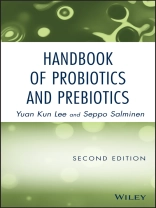Since the publication of the first edition in 1999, the science of probiotics and prebiotics has matured greatly and garnered more interest. The first handbook on the market, Handbook of Probiotics and Prebiotics: Second Edition updates the data in its predecessor, and it also includes material topics not previously discussed in the first edition, including methods protocols, cell line and animal models, and coverage of prebiotics. The editors supplement their expertise by bringing in international experts to contribute chapters. This second edition brings together the information needed for the successful development of a pro- or prebiotic product from laboratory to market.
Table of Content
PART I: PROBIOTICS.Chapter 1: Probiotic microorganisms.
1.1 Definition.
1.2 Screening, identification and characterization of Lactobacillus and Bifidobacillus strains.
1.3 Detection and enumeration of gastrointestinalmicroorganisms.
1.4 Enteric microbial community profiling in gastrointestinaltract by Terminal-Restriction Fragment Length Polymorphism(T-RFLP).
1.5 Effective dosage for probiotic effects.
1.6 Incorporating probiotics into foods.
1.7 Safety of probiotic microorganisms.
1.8 Legal status and regulatory issues.
Chapter 2: Selection and maintenance of probioticmicroorganisms.
2.1 Isolation of probiotic microorganisms.
2.2 Selection of probiotic mircroorganisms.
2.3 Maintenance of Probiotic Microorganisms.
Chapter 3: Genetic modification of probioticmicroorganisms.
3.1 Mutants obtained from probiotic microorganisms by randommutagenesis.
3.2 Plasmids.
3.3 Vectors for Lactobacilli and Bifidobacteria.
3.4 Genetic recombination.
Chapter 4: Role of probiotics in health and diseases.
4.1 Cell line models in research.
4.2 Laboratory animal models in research.
4.3 Effects on human health and diseases.
4.4 Effects on farm animals.
Chapter 5: Mechanisms of probiotics.
5.1 Adhesion to intestinal mucus & epithelium byprobiotics.
5.2 Combined probiotics and pathogen adhesion andaggregation.
5.3 Production of antimicrobial substances.
5.4 Immune effects of probiotic bacteria.
5.5 Alteration of microecology in human intestine.
Chapter 6: Commercially available human probioticmicroorganisms.
6.1 Lactobacillus acidophilus, LA-5?.
6.2 Lactobacillus acidophilus NCDO1748.
6.3 Lactobacillus acidophilus NFCM.
6.4 Lactobacillus casei Shirota.
6.5 Lactobacillus gasseri OLL2716 (LG21).
6.6 Lactobacillus paracasei ssp paracasei, F19®.
6.7 Lactobacillus paracasei ssp paracasei, L. CASEI431®.
6.8 Lactobacillus rhamnosus GG, LGG®.
6.9 Lactobacillus rhamnosus, GR-1® and Lactobacillusreuteri , RC- 14®.
6.10 Lactobacillus rhamnosus HN001 and.
6.11 LGG®MAX, a multispecies probiotic combination.
6.12 Bifidobacterium animalis ssp. lactis, BB-12®.
6.13 Bifidobacterium breve strain Yakult.
6.14 Bifidobacterium longum BB536.
6.15 Bifidobacterium longum strains BL46 and BL2C – Probioticsfor adults and ageing consumers.
PART II: PREBIOTICS.
Chapter 7: Prebiotics.
7.1 The prebiotic concept.
7.2 A brief history of prebiotics.
7.3 Advantages and disadvantages of the prebiotic strategy.
7.4 Types of prebiotics.
7.5 Production of prebiotics.
7.6 Prebiotic mechanisms.
7.7 Modulating the intestinal microbiota in infants.
7.8 Modulating the intestinal microbiota in adults.
7.9 Modifying the intestinal microbiota in the elderly.
7.10 Health effects and applications of prebiotics.
7.11 Functional foods for animals.
7.12 Safety of prebiotics.
7.13 Regulation of prebiotics.
7.14 Conclusion.
About the author
YUAN KUN LEE, PHD, is an Associate Professor in the Department of Microbiology at the National University of Singapore, where he researches fermentation and microbe-host interactions and probiotics. Dr. Lee has written ninety journal papers, sixty conference proceedings, twenty-eight book chapters, and three books. He is also the holder of three patents.SEPPO SALMINEN, PHD, is a Professor in the Department of Biochemistry and Food Chemistry at the University of Turku in Finland. He is also a Visiting Professor of Food Toxicology at RMIT University in Australia. Prior to his academic career, Dr. Salminen worked as a nutrition specialist, project manager, and toxicologist for private industry and government agencies. Dr. Salminen has written more than 240 refereed publications, several book chapters, and five books.
Language English ● Format PDF ● Pages 624 ● ISBN 9780470432617 ● File size 3.5 MB ● Publisher John Wiley & Sons ● Published 2009 ● Edition 2 ● Downloadable 24 months ● Currency EUR ● ID 2317312 ● Copy protection Adobe DRM
Requires a DRM capable ebook reader












